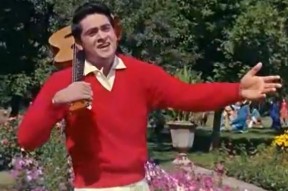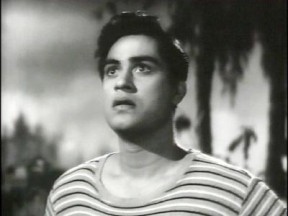
Just an observation. No one filled a T-shirt quite like Joy Mukherjee. Remember him pulling a rickshaw (in a striped T-shirt) with the fragile Sadhna in his debut film Love in Simla? Or him serenading Sharmila Tagore with Dil Ki Awaz Bhi Sun in Humsaya (yes, again in a t-shirt, red this time) and he and Saira Banu going around the melodic loops of ‘O ho’ in Woh Hain Zara Khafa Khafa in Shagird (where ofcourse he wore another T-shirt!)? Yup, no one wore them better.
We never watched his films for histrionics but because he was the perfect template for a suitable boy. A broad-shouldered, athletic, clean cut, eligible bachelor with slick hair, a half smile, eyes that were comical one instant and full of a puppy’s adoration, the next. He basically radiated sunshine. Someone that vampish rich girls in films wanted to snag as a trophy boy friend or husband and poor, emotionally suppressed girls dreamt of wistfully. It was easy to understand why a bespectacled, clumsy Sonia (Sadhna before a fringe and a make over) in Love In Simla would want to steal him away from her cousin, the beautiful Sheela (Azra). He made a great bone of contention between two women and looked worthy of their jealousy and machinations. He played many variations of Love In Simla’s rich, good looking boy who lived in a big house and possibly never suffered a moment of self-doubt till love complicated the best laid plans.

This was possibly the best film to showcase the essence of Joy Mukherjee. A well-groomed, genial hero who could make you believe that love was just a glance away, that music was part of everything whether you were imparting a home work lesson to a young child, begging forgiveness from your girl friend who after having cooked a big meal waited for you in vain or when you looked desperately for her under layers of snow. With Joy Mukherjee, you don’t remember the dialogues, the films so much as the songs. Him playing an amnesiac in Ek Musafir Ek Haseena, singing songs that seemed to have been painted on Kashmir’s canvas. My favourite being Mujhe Dekh Kar Aapka Muskurana, where he is a clown, a suitor, a slightly unhinged lover. Or him looking for the woman of his dreams and singing Lakhon Hai Nigaah Mein in Phir Wohi Dil Laya Hoon with that strange manic gleam in his eyes that perhaps his directors mistook for ardour.

Joy Mukherjee was not an actor for all seasons but in 60’s frothy romances, he brought with him unexpected sartorial elegance and a fundamental niceness that made him look wholesome no matter what he was given to do. He was taller than most heroes of his time and better built than most but his face had an innocence that reminded you of a trusting child. There never was a whiff of scandal about him even off screen and once he was phased out of his kind of cinema by edgier, darker heroes, he stayed away from spot light, returning only to direct the ill-fated Humsaya and the moderately successful Chaila Babu. The son of Sashadhar Mukherjee (one of the co-founders of Filmalaya Studios) never threw his weight around and did not chase success but enjoyed it while it lasted.
To those of us who remember him, he however remains a romantic hero we all wanted to meet when we grew up. Someone who whispered in Mohammed Rafi’s voice, “Aa ja re aa zara aa” to Asha Parekh in Love in Tokyo and made us catch our breath because his face drenched in rain exuded such passion and also because even in that ridiculously feminine, floral shirt, he was a man. And most importantly, a gentleman.
Rest in peace Joy Mukherjee. And like a fan said on Facebook, “thanks for hours of undiluted joy.”









Oh how could I forget the amnesiac romance of him and Sadhana in ek musafir ek haseena..he was quite different from other heroes, no swag, no air..like you said the suitable boy..love in shimla, love in Tokyo has been my his favorites after ek musafir ek haseena..
You said it all and oh so perfectly. I discovered him only recently via utube. If he had had an iota of SRKs success drive, Joy would be the only King of Romance for eons of time. A young Joy would be just ideal for Deepika P and no kapoors, khans , kumars could match that. If a Dilip K made one cry, or an Amitabh got one angry or a Rajesh K batted his eyes foolishly – Joy was sufficient just to bring a joyful smile to one. He looked so hollywoodish rather than bollywoodish. Wish i could pay him back in some way for the joy of wathching his movies.
What needs to be understood is that ‘the suitable boy’ communicated unbridled passion under that calm pleasant exterior. I believe he truly loved the women he worked with and this is true for Saira Banu more so than others. The extra second that his gaze lingered on her face, the gentle rubbing of his cheeks across her hair, the gentle yet firm hold on her shoulders gave him away but the gentleman that he was there was no way he would come out and express it. I don’t think Saira Banu had the sensitivity at that time to gauge his feelings for her. That he continued to act with her despite their films not doing well at the box office further seals this I think. I also think he was greatest romantic hero and was not given his due by the industry. The industry also failed to tap his full potential for sensitive roles. His movies are among the most entertaining of all times. His various disguises in his movies be it the sadhu in Dil Chahta Hai or Siddhi or the Gujarati hakim in Saaz aur Aawaz or the old man that rides the scooter with Shamila Tagore in Dil aur Mohabbat were all perfectly executed. Finally he not only filled his T-Shirts well with that strong back and chest but had the perfect body for a shrewani as you can see in the highly romantic song ek baar phir kaho zara in the movie Saaz aur Aawaz. It’s hard to stop when I start on him. Enough now!